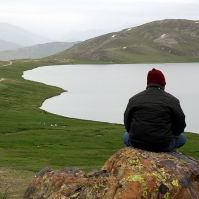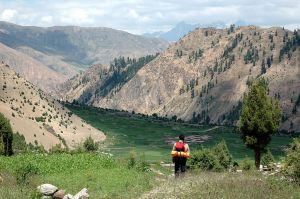America the Beautiful: Hike America’s Trails
 Did you know that National Trails Day is June 7? The 15th anniversary of this national celebration of America’s hiking trails is right around the corner, so get involved and go take a hike.
Did you know that National Trails Day is June 7? The 15th anniversary of this national celebration of America’s hiking trails is right around the corner, so get involved and go take a hike.
The reports are out and it’s official: hiking is in. According to the Outdoor Industry Association’s Outdoor Recreation Participation Study 2006, 76.7 Americans participate in hiking, 13.5 million are into backpacking, and 40.4 million are trail runners.
Since trails often cross-cut several federally-managed and private land, it’s difficult to determine just how many miles are out there, but it’s estimated that there are 200,000 miles of trails in the United States.
More than you thought, right?
You’re probably familiar with some of these top national trails:
Appalachian National Scenic Trail is a 2,175-mile trail that runs from Maine to Georgia. It’s estimated that 3 to 4 million visitors hike a portion of the Appalachian Trail each year, and since 1936, more than 9,000 hike completions have been recorded by Appalachian Trail Conservancy. The trail runs from the rugged White Mountains of Maine, the Blue Ridge Mountains and onto Clingman’s Dome in the Great Smoky Mountains National Park. www.appalachiantrail.org
Related articles:
Continental Divide National Scenic Trail runs 3,100 miles from the Mexican border to the Canadian border along the “backbone” of America. The trail passes through Glacier National Park, the Chinese Wall in the Rocky Mountains and the Red Rock Lakes National Wildlife Refuge. www.cdtrail.org
Pacific Crest National Scenic Trail zigzags for 2,650 miles from Mexico into California, Oregon and Washington, including Yosemite National Park, Mt. Shasta and the remote Northern Cascades. www.pcta.org
 In fact, to complete all three trails is called a Triple Crown. In 2005, a man named Mat “Squeaky'” Hazley hiked up the Pacific Crest Trail, down the Continental Divide Trail and up the Appalachian Trail all in succession—that’s 7,400 miles through 22 states! He was only the third person to hike each of the three U.S. National Scenic Trails in a calendar year and the first to do it in only 240 days.
In fact, to complete all three trails is called a Triple Crown. In 2005, a man named Mat “Squeaky'” Hazley hiked up the Pacific Crest Trail, down the Continental Divide Trail and up the Appalachian Trail all in succession—that’s 7,400 miles through 22 states! He was only the third person to hike each of the three U.S. National Scenic Trails in a calendar year and the first to do it in only 240 days.
But what about those lesser-known trails—the ones that are practically in your own backyard? The key is to figure out what type of trail is best for your level of fitness, what sort of terrain you want to travel, and what kind of scenery inspires you.
Looking to catch a spectacular sunset as you hike along the beach? Try the Olympic Coastal Strip in Washington’s Olympic National Park.
Want to take a dip under a roaring waterfall? Head to North Carolina’s Nantahala National Forest.
The American Hiking Society put together this list of “The Best Unknown Rivers and Trails of the National Landscape Conservation System.”
- Chain of Craters Area, New Mexico. This section of the Continental Divide National Scenic Trail crosses New Mexico’s volcanic badlands, offering views of lava fields and volcanic calderas.
- Little Blitzen Gorge Trail, Oregon. This path is less challenging, takes you through wildflower meadows and into a gorge of heavy waterfalls.
- Lost Coast Trail, California. Part of the California Coastal Trail, this beachside walk passes by old lighthouse ruins and provides a view of the 4,087-foot high King’s Peak.
- Paria Canyon, Arizona. The Vermillion Cliffs Wilderness Trail is cut by the Paria River which created a 38-mile long canyon for moderate hiking.
- Pinnel Mountain Trail, Alaska. Here is where you can take a summer hike to a view of the White and Crazy Mountains under Alaska’s midnight sun.
Family-Friendly Trails
These were chosen based on the trails’ accessibility to a major city, ease and amenities.
1. Lizzy’s Trail – Boston: Located 45 minutes from downtown Boston, this hike covers about two miles along the Ipswich River. The first section, Lizzy’s Trail, is named for Lizzy Heerlein, a local resident.
2. Illinois & Michigan Canal – Chicago: Forty-five minutes from downtown Chicago is the 3-mile trail segment from Channahon to McKinley Woods.
3. Ohio & Erie Canal Trail – Cleveland: The 4.3-mile segment from Boston Shore to Station Road Bridge is 30 minutes from downtown Cleveland. Highlights include the Boston Store constructed in 1836 and the Station Road Bridge, constructed in 1881.
4. The Long Path – New York/New Jersey: Most of the Long Path is in New York, but the 3.3-mile section from Fort Lee to Rockefeller lookout takes you along the Palisades of the Hudson River in New Jersey, overlooking Manhattan.
5. Florida Trail – Orlando: Twenty minutes from downtown Orlando is the 4.8-mile trail (round trip) from Barr Street trailhead. This trail is a haven for wildlife including fox, otters, bobcats, sandhill cranes, wild turkeys, bald eagles and osprey.
6. Great Allegheny Passage – Pittsburgh: Twenty minutes from downtown Pittsburgh is the 2.3-mile Dead Man’s Hollow Hike which runs north from Boston on the Youghiogheny River Trail. This grade and others are being linked together to form a 150 mile trail called the Great Allegheny Passage.
7. Horsetail & Ponytail Falls – Portland (OR): Locate 45 minutes from downtown Portland is this 2.7-mile loop beginning at Old Columbia Highway. The hike is located in a scenic area of the Columbia River gorge known as “waterfall alley
8. KATY Trail – St. Louis: This 5.7-mile linear hike follows the KATY rail-trail, 50 minutes from downtown St. Louis. When complete, 247 miles of trail will be available for recreation.
9. Point Reyes – San Francisco Bay Area: This is a 5-mile gentle walk through coastal scrub and grasslands Laguna Loop, 45 minutes from downtown San Francisco.
10. C&O Canal – Greater Metro Washington, DC: Twenty minutes from downtown Washington, D.C. is this 2.3-mile hike starting from Angler’s Inn toward Great Falls Tavern. The Billy Goat Trail and the Washington Aqueduct provide opportunities for loop hikes in the area.
Leave No Trace
The “Leave No Trace” principles come from the Leave No Trace Center for Outdoor Ethics (www.lnt.org), an international nonprofit organization dedicated to building awareness about responsible outdoor activities:
- Plan ahead and prepare: Know the type of terrain and possible weather conditions you might encounter. Minimize impacts by keeping groups small.
- Travel and camp on dependable surfaces: Focus activity on resilient ground. Surfaces consisting of sand, gravel, rock, snow, or dry grass are durable and can withstand heavy use. Walking single file and avoiding shortcuts will limit damage to the trail and surrounding ecosystems. Walk through mud/puddles to avoid widening the trail.
- Dispose of waste properly: Pack it in. Pack it out! Clean up all trash and leftover food and properly dispose of human waste. Leave the areas you enjoy as good, if not better than you found it.
- Leave what you find: You can look, but don’t take. Leave everything that you find in the wilderness where it belongs. Take pictures instead; it allows others to enjoy the same experience.
- Minimize campfire impacts: Keep your campfire small—or go without. Use previously constructed fire rings or mounds. Be aware of the level of fire danger of the area. Burn all wood and coals to ash, put campfire out completely, then scatter cool ashes.
- Respect wildlife: Never feed animals! Let the wild be wild. Keep your distance and do not attract or approach them.
- Be considerate of other visitors: Show respect for other trail users. Keep voices/noises from getting intrusively loud. Be courteous and yield to other users on the trail.
To get started on your next trail walk, check out these resources:
This is an excerpt from Peter Greenberg’s Travel Detective Bible. Statistics have been updated.
Looking for more outdoor adventures? Check out America the Beautiful: Hidden National Parks. as well as America the Beautiful: Five More Hidden National Parks.
Looking for a place to stay? Don’t miss the “Grand Dame” Hotels of the National Park System.
Check out more information on Hiking & Walking Getaways for You & Mom.
And if you don’t have full mobility, you can still hike. Don’t miss Adaptive & Accessible Hiking.
Related articles:












